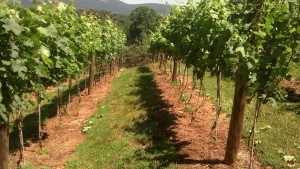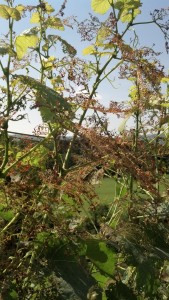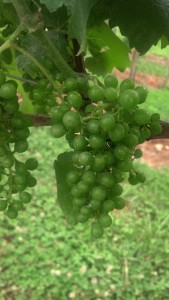Tag: shoot thinning
How I Came to Love the Idea of Mechanization
Well, the good news is that we no longer need to hedge most of our grapevines. The bad news is that when we arrived at the vineyard two weeks ago, we found the upper third of the vines covered with Japanese Beetles who were partying as though the wine had already been made and they had just broken into the cellar. They were chowing down on the leaves, having sex, and in some cases, doing both at once. I almost hated to interrupt.
But, of course I did. More on that in a moment. But first, you may be wondering what that has to do with mechanization. So, let me explain. (This will take some time.)

Looking good: the vineyard in the weeks before the Japanese Beetles launched their assault (and before leaf pulling).
A week earlier, I had arrived home in Fairfax, exhausted and in pain, after a short overnight trip to the vineyard. I had made the trip strictly for the purpose of spraying, and I had no idea what I was in for.
With recent rains and warm weather, conditions in the vineyard were ripe for a bunch of fungal diseases, so spraying was a necessity. But the abundant rainfall we’ve received this year had also prompted amazing vine growth.
Stepping back for a moment, let me say that we had taken steps to control the vines’ vigor. Specifically, we had finished shoot thinning and done some leaf pulling a few weeks earlier (this takes us back to the first or second week of June).
Shoot thinning and leaf pulling are part of the process of maintaining balance in the vine. More on this in a future post, but for now, suffice it to say that shoot thinning and leaf pulling help open up the canopy for air flow and spray efficiency, among other things, and shoot thinning ensures that the crop load of grapes is optimal for the vine. That means that the clusters of grapes that remain on the vine get sufficient sugar from photosynthesis to make good wine.
However, for all our work, it turned out that the vines still had many more shoots and many more leaves than they needed. And each leaf has to be covered, top and bottom, with fungicide. No exceptions!
In a commercial vineyard, we’d use an airblast sprayer that would spray a fine mist deep into the vine canopy, covering each leaf top and bottom as the tractor moved down the rows. Good canopy management helps, of course; spray efficiency is improved in a well-maintained canopy with properly separated shoots and an optimal number of leaves. But whatever else we might want to do, an airblast sprayer is clearly superior to what I’ve been using.
Uh, yeah. Clearly superior in the way that a Lexus is clearly superior to a bicycle as a mode of transportation.
What we had been using for the past two years were two-gallon, hand-pump sprayers. But I had moved on to a four gallon backpack sprayer that is continually pumped as I move through the vineyard. The sprayer weighs 43 pounds when full, and the pumping action has the effect of exerting even more weight on one shoulder.
Now, when I describe our little hobby vineyard to friends, the 225 vines we maintain seem pitifully – almost embarrassingly – small. But when I’m spraying, it seems huge – really, really, really huge.
On that particular weekend two weeks ago, I spent about five hours spraying some 20 gallons of chemicals. The backpack sprayer was heavy enough that the only way I could get it on was to sit on the ground with my back toward it, pull the straps around my shoulder, then turn to my side to get some leverage as I used my arms to push me to a standing position. That’s a technique I learned in the Army when we carried much heavier packs. But of course I was so much younger then.
The long and the short of it is that I wasn’t just exhausted when I finished, I was in considerable pain. The pack was heavy, it required constant pumping on one side which really hurt my shoulder. So, as I sprayed fungicide, I observed that a small number of Japanese Beetles were beginning to make themselves at home in our vineyard, but I was frankly too tired to care.
After I finished and cleaned up, I limped home, vowing that I would find a better way to handle the spraying.

The vines are okay, but it’s still heartbreaking to see this kind of damage. Zoom in, and you’ll see what I mean.
The following weekend, I came face to face with the consequences of my decision to avoid dealing with the Japanese Beetles. As I said earlier, our vines were covered with thousands of the little buggers, and the damage looked extensive. Many of the vines had lost all of the leaves at the top, while others appeared to be almost totally denuded.
So, we sprayed again. That weekend, the Vineyard Goddess was with me and she handled half the spraying. We were in a bit of a panic over the amount of damage, and so we immediately sprayed the vines with Sevin. Ordinarily, that would have been it, since the vines had received ample fungicide the previous weekend. But with all the rain from the past week, I wondered the next day if we should spray a fungicide. We assumed, however, that a second spray would wash off the Sevin, and we were more concerned at that point about the Japanese Beetles than the possibility of fungal diseases on vines that, honestly, seemed amazingly free of disease.
And need I say that a second spraying session that weekend would have involved some four to five man-hours of labor. Not that the labor had anything to do with my decision.
Which brings me back to my new-found love for the idea of mechanization. I would like to say “love of mechanization,” but I haven’t actually mechanized anything yet. It’s still in the idea stage. I’ve done a lot of research, though – enough to know that it probably won’t make economic sense to buy the airblast sprayer that I really want.
I suspect I’ll end up with a sprayer that will attach to a tractor and provide a long hose so that I can park at one end of a row and work my way through the vines holding nothing more than the sprayer nozzle and some part of the hose. I’ll use either my John Deere 2320 or, more likely a new 500 series John Deere tractor that is smaller, more maneuverable and more appropriate to the hobby vineyard we have. (But no, I’m not getting rid of the 2320 – the front-end loader by itself justifies the cost. At least that’s my story, and I’m sticking to it.)
In any event, I’ve fallen in love with the idea of mechanization. Before too many more weeks pass, I hope to make it a reality.




Recent Comments